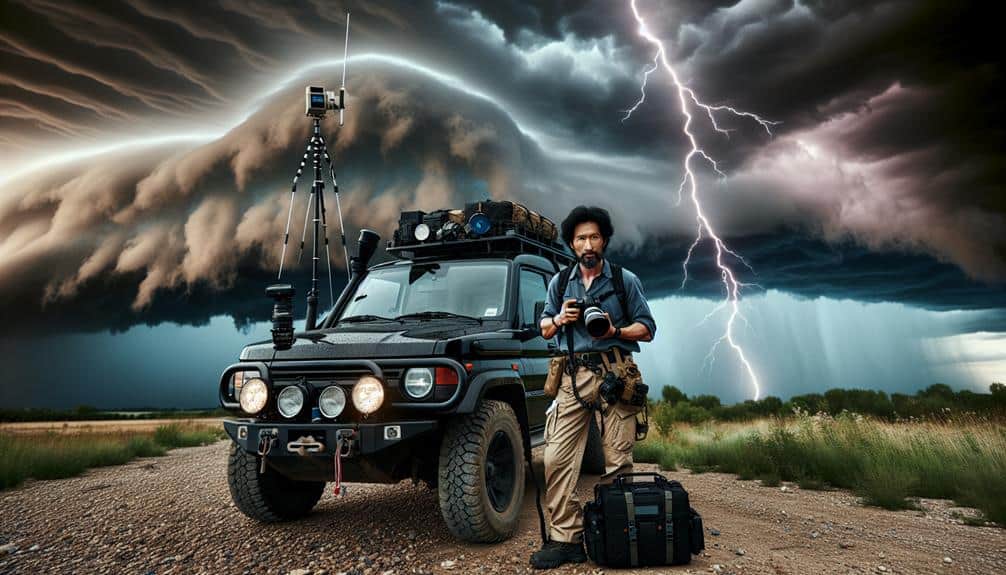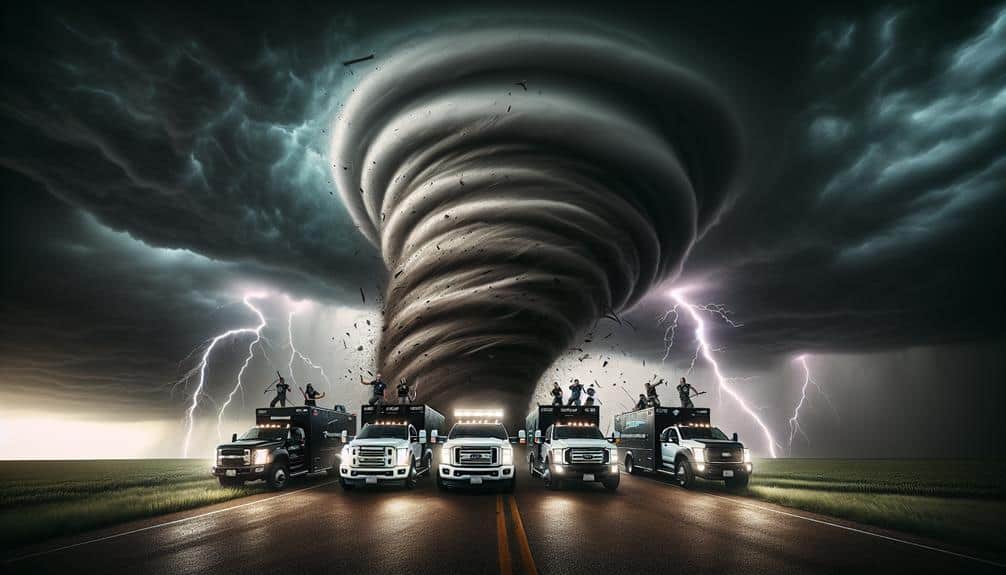When planning our storm chasing adventure in 2022, we need to prioritize selecting a reputable tour company by analyzing their experience, safety records, and success rates. Prime locations are in Tornado Alley, focusing on Oklahoma, northern Texas, and southern Kansas, during late spring to early summer. Essential gear includes high-definition radar systems, GPS units, all-weather gear, and advanced camera equipment. Safety protocols, such as emergency preparedness and continuous weather monitoring, are mandatory. By interpreting radar reflectivity and synoptic scale charts, we can anticipate storm patterns accurately. Booking options vary by package and services, and there's more to uncover.
Key Points
- Select a reputable tour company with high safety ratings and positive customer reviews.
- Focus on Tornado Alley hotspots like Oklahoma, northern Texas, and southern Kansas during late spring to early summer.
- Equip yourself with high-definition radar systems, GPS units, and all-weather gear.
- Regularly monitor weather updates and have clear emergency and evacuation plans.
Choosing a Tour Company
Selecting the right tour company is important because it directly impacts our safety, experience quality, and overall success rate in storm chasing. When we look at tour operator comparisons, it's vital to analyze their experience, safety records, and success rates.
Companies with a long history of storm chasing often have refined their techniques and protocols, ensuring our adventure is both exciting and secure.
We should immerse ourselves in customer reviews to gather firsthand accounts of past participants. These reviews provide valuable insights into the tour operators' professionalism, equipment quality, and customer service.
For instance, one tour company might boast a 95% success rate in seeing tornadoes, while another might have a higher safety rating but a slightly lower success rate.
Best Locations for Storm Chasing
Let's pinpoint the best locations for storm chasing by focusing on Tornado Alley hotspots, prime storm seasons, and ideal observation points.
We'll consider statistical data on tornado frequency and intensity to identify key areas.
Understanding these factors guarantees we maximize our chances of safely encountering severe weather phenomena.
Tornado Alley Hotspots
Tornado Alley offers some of the most thrilling storm chasing experiences, with hotspots such as Oklahoma's central region, northern Texas, and southern Kansas frequently producing severe weather events. These areas are renowned for their high incidence of tornadoes and severe thunderstorms, making them prime locations for storm photography and storm tracking.
In Oklahoma's central region, we often encounter supercell thunderstorms with well-defined mesocyclones, which are perfect for capturing dramatic storm photographs. Central Oklahoma's flat terrain provides unobstructed views, ideal for observing and documenting storm structures.
Northern Texas is another hotspot, where the confluence of warm, moist Gulf air and dry, cool air from the Rockies creates a volatile environment conducive to severe weather. We can leverage advanced storm tracking technology to monitor storm development and position ourselves strategically to witness tornado genesis and capture striking imagery.
Southern Kansas offers a blend of rolling plains and open landscapes, facilitating both storm tracking and photography. The region's frequent severe weather outbreaks present numerous opportunities to document the awe-inspiring power of nature. By utilizing real-time radar data and predictive models, we can navigate these hotspots effectively, ensuring both safety and best positioning for our storm chasing endeavors.
Prime Storm Seasons
Understanding the key storm seasons is essential for maximizing our chances of encountering severe weather in Tornado Alley. Peak activity typically occurs from late spring to early summer. During this period, the convergence of warm, moist air from the Gulf of Mexico and cold, dry air from Canada creates ideal conditions for severe thunderstorms and tornado formation.
We should focus our efforts on key months: May and June. Historical data shows that these months yield the highest frequency of tornadoes, with the National Weather Service reporting an average of 187 tornadoes in May alone. Storm tracking technology, such as Doppler radar and satellite imagery, becomes vital for pinpointing storm cells and predicting their paths.
When planning our excursions, we must consider significant geographical regions. Central Oklahoma, northern Texas, and southern Kansas stand out as prime locations due to their storm-prone environments. These areas offer the best opportunities for storm photography, with their expansive plains providing unobstructed views of supercell structures and lightning displays.
Ideal Observation Points
Selecting the best observation points is vital for storm chasing, and we must prioritize regions with high visibility and accessibility to maximize our data collection and photographic opportunities. Scenic overlooks and remote areas are prime targets due to their unobstructed views and minimal light pollution. Regions like the Great Plains in the United States offer unparalleled visibility, with flat terrains that allow us to monitor storm developments from miles away.
Identifying hidden gems and unexpected viewpoints is equally crucial. These locations often provide unique vantage points that standard observation spots can't offer. For example, the Sandhills of Nebraska, with their rolling dunes, present a dramatic backdrop for storm photography and data collection. Similarly, remote areas in Kansas, where open skies meet the horizon, allow for uninterrupted observation, optimal for tracking storm evolution.
Using geographic information systems (GIS) and meteorological data, we can pinpoint ideal observation sites. We should also consider accessibility, ensuring that our vehicles can navigate the terrain swiftly.
Essential Gear and Equipment

Equipping ourselves with high-definition radar systems, GPS navigation units, and durable all-weather gear is vital for a successful storm chasing expedition. Accurate data from radar systems allows us to anticipate storm movements and identify supercells with precision. GPS navigation units guarantee we can maneuver through remote areas efficiently, while rugged clothing and footwear protect us from harsh weather conditions.
Preparation is key; bringing emergency supplies such as first-aid kits, non-perishable food, and water ensures we're ready for any unforeseen circumstances. A well-stocked emergency kit can make the difference between a minor setback and a critical situation.
Camera equipment is essential for documenting our adventures. High-quality DSLR cameras with fast shutter speeds capture the intricate details of storm formations. Wide-angle lenses are optimal for panoramic shots, while telephoto lenses allow us to focus on distant tornadoes.
Mastery of photography techniques like long exposure and HDR imaging enhances our ability to document these natural phenomena in all their glory.
Safety Tips and Guidelines
Prioritizing our safety is crucial, so we adhere to strict guidelines and have contingency plans in place to mitigate risks while storm chasing.
First, our emergency preparedness involves a multi-tiered approach: we keep a well-stocked emergency kit including first aid supplies, water, non-perishable food, and a portable weather radio. Additionally, we ensure our vehicles are in prime condition, with full gas tanks, spare tires, and essential tools for quick repairs.
Effective communication strategies are vital for our safety. We use a combination of satellite phones, two-way radios, and mobile apps to stay connected with each other and local emergency services. Real-time data sharing through GPS tracking guarantees that everyone knows our precise locations, reducing the risk of getting lost or separated.
We also implement strict protocols for when and where to chase, based on real-time meteorological data. If conditions become too hazardous, we've predefined evacuation routes and meeting points. We monitor weather updates continuously, using advanced radar systems and storm tracking software, to make informed decisions quickly.
Understanding Weather Patterns

To effectively chase storms, we must analyze meteorological data, such as radar images and satellite outputs, for accurate forecasting.
We identify storm indicators, including barometric pressure drops and wind shear patterns, to determine potential storm formation.
Analyzing Meteorological Data
When analyzing meteorological data, we focus on identifying key weather patterns through advanced radar imagery and satellite data interpretation. By leveraging these tools, we can detect storm indicators such as wind shear, updrafts, and pressure drops. These elements are critical in understanding weather changes and predicting potential storm developments.
To start, we examine radar reflectivity data to identify precipitation intensity and structure. Doppler radar provides us with velocity data, allowing us to pinpoint rotation within storm cells, a key indicator of tornado potential. Satellite data, particularly from geostationary satellites, offers a broader view of cloud formations, temperature gradients, and moisture content in the atmosphere.
Next, we analyze synoptic scale charts to assess large-scale weather patterns. This includes studying high and low-pressure systems, frontal boundaries, and jet stream locations. These elements influence storm development and movement, providing us with critical insight into where severe weather is likely to occur.
Identifying Storm Indicators
By closely examining wind patterns, temperature fluctuations, and atmospheric pressure changes, we can identify essential storm indicators that signal the onset of severe weather events. Recognizing shifts in these weather conditions is critical for anticipating storm formations.
First, let's focus on wind patterns. Wind shear, which involves changes in wind speed and direction with altitude, is a primary indicator of potential storm development. When we observe significant wind shear, it's often a precursor to supercells and tornadoes.
Next, we need to monitor temperature fluctuations. A rapid rise in temperature, particularly in the lower troposphere, often signifies the destabilization of the atmosphere. This thermal energy fuels storm formations, increasing the likelihood of thunderstorms and other severe weather phenomena.
Lastly, atmospheric pressure changes are key storm indicators. A sudden drop in barometric pressure usually points to an approaching storm system. Low-pressure systems are typically associated with bad weather, and their detection allows us to predict storm formations with greater accuracy.
Predicting Weather Changes
Understanding weather patterns relies on our ability to analyze historical data and real-time observations to predict impending weather changes with high accuracy. Leveraging advanced weather forecasting models, we can decode the complexities of atmospheric dynamics. These models assimilate data from satellites, radars, and weather stations, providing us with predictive insights essential for storm chasing.
Climate change has introduced new variables into our forecasting equations, necessitating continuous adaptation. The increased frequency and intensity of severe weather events mean we must refine our predictive algorithms to maintain reliability. Our real-time data acquisition systems, coupled with machine learning techniques, enhance our ability to anticipate storm developments and track their paths.
In our quest for freedom and adventure, we can't overlook the significance of disaster preparedness and emergency response. By understanding weather patterns and predicting changes, we not only guarantee our safety during storm chasing but also contribute valuable information to local authorities. This synergy between our predictive capabilities and emergency response frameworks is vital in mitigating risks associated with severe weather.
Ultimately, precise weather forecasting empowers us to make informed decisions, enhancing our storm chasing experiences while prioritizing safety and preparedness in the face of unpredictable climatic shifts.
Booking and Pricing Information
To secure your place on our 2022 storm chasing adventure, you can book directly through our website with a detailed pricing breakdown provided for various package options. Early reservations are highly recommended to guarantee availability and benefit from cost comparison across our offerings. By booking early, you can lock in the best rates and choose from a wider array of dates and services.
Our website outlines the payment options available to accommodate different preferences. We accept major credit cards, PayPal, and offer installment plans for those who prefer to spread out the payments. This flexibility guarantees you can manage your finances while still enjoying the thrill of storm chasing.
We've organized our package deals into three tiers: Basic, Advanced, and Premium. Each tier includes varying levels of accommodations, equipment, and guided expertise. The Basic package starts at $1,200, offering essential services for a memorable experience.
The Advanced package, priced at $2,500, includes enhanced features such as upgraded lodging and specialized meteorological tools. The Premium package, at $4,000, provides an all-inclusive experience with luxury accommodations, detailed storm tracking technology, and one-on-one guidance from expert storm chasers.
Booking early and selecting the right package ensures a smooth, exhilarating adventure.
Frequently Asked Questions
What Is the Best Time of Year to Go Storm Chasing?
The best time for storm chasing is spring, when weather patterns are most active. We should prioritize safety precautions, choose popular locations like Tornado Alley, and guarantee we've got the necessary equipment needed for accurate data collection.
Do I Need Prior Experience to Join a Storm Chasing Tour?
Think of storm chasing as maneuvering a thrilling, unpredictable dance. We don't need prior experience to join a storm chasing tour. Expert guides guarantee adherence to safety precautions and provide the necessary equipment, securing our adventure's freedom.
How Physically Demanding Is a Storm Chasing Adventure?
The physical demands of storm chasing vary; however, we should consider our fitness level and adhere to safety precautions. Activities often involve prolonged standing, quick movements, and potential exposure to harsh weather conditions, necessitating moderate physical endurance.
Are There Age Restrictions for Participating in Storm Chasing Tours?
Yes, there are age restrictions for storm chasing tours. Safety concerns dictate that minors must have parental consent. Typically, participants need to be at least 18, but some tours allow younger individuals with proper authorization.
Can I Bring My Own Vehicle for Storm Chasing?
We've analyzed the data, and most tours impose vehicle restrictions. However, some companies offer rental options. If you prefer freedom, verify directly with organizers to guarantee your own vehicle meets their specific safety and equipment standards.


